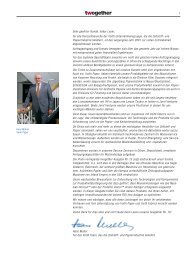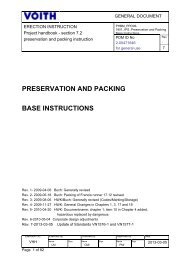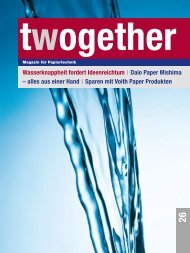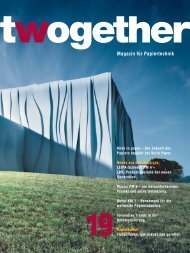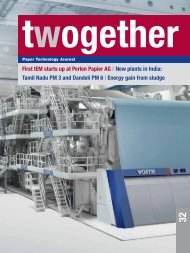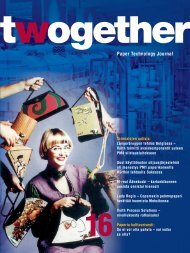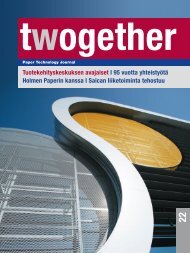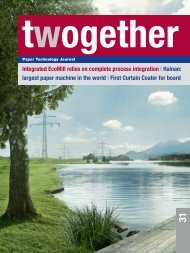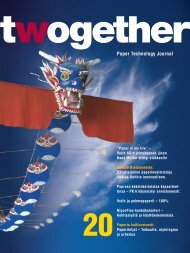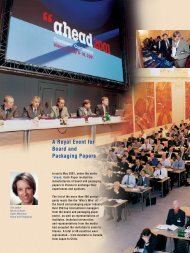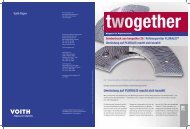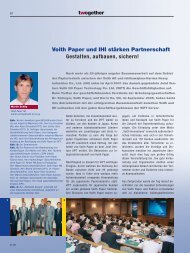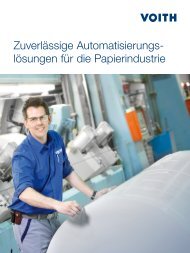Paper Technology Journal 19 - Voith
Paper Technology Journal 19 - Voith
Paper Technology Journal 19 - Voith
You also want an ePaper? Increase the reach of your titles
YUMPU automatically turns print PDFs into web optimized ePapers that Google loves.
68<br />
Fig. 4: <strong>Paper</strong> destroyed by acids.<br />
Fig. 5: Mold damage.<br />
Fig. 6: Damage caused by aggressive inks.<br />
Fig. 7: An extensively damaged map.<br />
Acid damage to paper – the<br />
biggest problem and challenge<br />
Books are part of our cultural heritage,<br />
but are exposed to many different dangers.<br />
The worst of these are not bookworms,<br />
bark beetles or other destructive<br />
insects, nor even mold or similar problems<br />
caused by incorrect handling of<br />
valuable volumes. If asked about the<br />
main priorities in the preservation of old<br />
books, Dr. Manfred Anders, the ZFB’s<br />
General Manager, is sure that the main<br />
challenge for the future will be to stop<br />
acid decay, which according to current<br />
knowledge threatens at least two-thirds<br />
of the world’s most significant libraries,<br />
archives and document collections.<br />
The acids that cause this damage often<br />
enter the paper in the fillers or as a result<br />
<strong>19</strong>/05<br />
ZFB document restoration techniques:<br />
Fig. 8: Bulk deacidification, in which the books<br />
are soaked in a non-aqueous solution. A treatment<br />
capacity of more than 100 tons a year.<br />
Fig. 9: Aqueous fungicide treatment to eliminate<br />
mold spores.<br />
Fig. 10: Manual paper splitting.<br />
Gelatin is used to hold the damaged document<br />
between two supporting sheets of paper; it is then<br />
split apart so that it can be stabilized by inserting<br />
an interleaved core sheet between the two halves<br />
of the original document.<br />
of incorrect dosage of strengthening<br />
agents during the papermaking process,<br />
but environmental influences both past<br />
and present are also to blame. The acids<br />
break down the cellulose that provides<br />
the paper with its mechanical strength,<br />
whereupon it becomes brittle and breaks<br />
up easily. This is an auto-catalytic ageing<br />
process, in other words one that speeds<br />
up automatically and can only be countered<br />
by effective deacidification.<br />
The ZFB, had its origin in the restoration<br />
departments of two German libraries, the<br />
‘Deutsche Bücherei’ and the ‘Deutsche<br />
Bibliothek’, which were combined in<br />
Leipzig following the German reunification.<br />
For some time now it has confronted<br />
this specific acid-damage problem and<br />
developed equipment suitable for the<br />
bulk deacidification of books. Such large-<br />
Fig. 11: Mechanical paper splitting if the document<br />
is less severely fragmented. In this case, a<br />
thin but highly tear-resistant core sheet is inserted<br />
between the two halves.<br />
Fig. 12: Closing holes and gaps by mechanical<br />
fiber reconstruction. As in papermaking, a fiber<br />
suspension is applied to a screen in such a way<br />
that the fibers take up the desired position and are<br />
linked together.<br />
Fig. 13: Restoring damaged book covers and<br />
spines.<br />
4 5 6<br />
scale methods are clearly essential if the<br />
loss of possibly millions of important<br />
books is to be avoided. In <strong>19</strong>98 the ZFB<br />
ceased to be part of the Deutsche Bibliothek<br />
and became an autonomous institute.<br />
With its know-how, its experience<br />
and the methods at its disposal, it is today<br />
in a position to assist all international<br />
state-run and private bodies that have the<br />
task of maintaining important collections<br />
of books.<br />
The ZFB’s ‘<strong>Paper</strong>save’ process<br />
The books are pre-dried to reduce their<br />
natural moisture content temporarily<br />
from the usual 5-7% to below 1%. This<br />
is followed by the actual deacidification<br />
process, in which the books are soaked<br />
in an alkaline, non-aqueous solution. For<br />
8 9 10



